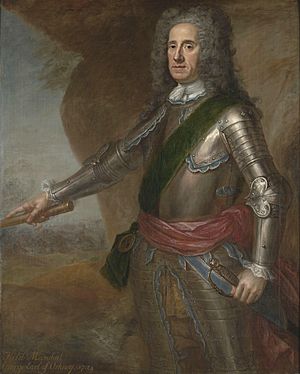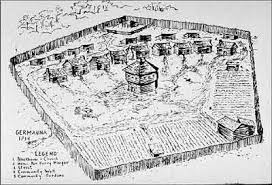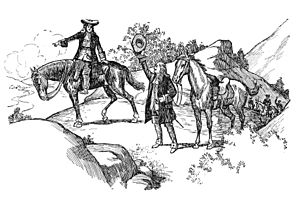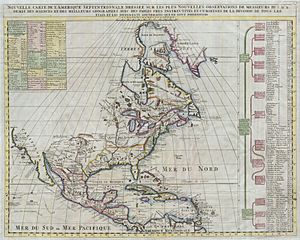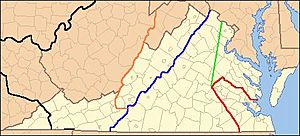Alexander Spotswood facts for kids
Quick facts for kids
Alexander Spotswood
|
|
|---|---|
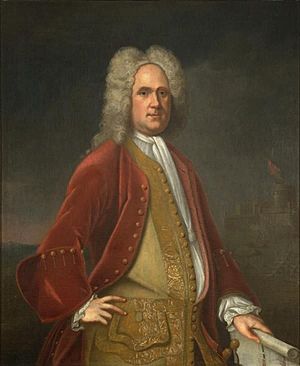
Charles Bridges, Portrait of Alexander Spottswood, 1736. Governor's Palace (Williamsburg, Virginia)
|
|
| Colonial Lieutenant Governor of Virginia | |
| In office 23 June 1710 – 27 September 1722 |
|
| Monarch | Anne – George I (from 1 August 1714) |
| Preceded by | Robert Hunter |
| Succeeded by | Hugh Drysdale |
| Deputy Postmaster General of North America | |
| In office 1730–1739 |
|
| Preceded by | John Lloyd |
| Succeeded by | Head Lynch |
| Personal details | |
| Born | 12 December 1676 English Tangier, Morocco |
| Died | 7 June 1740 (aged 63) Annapolis, Province of Maryland |
| Resting place | Temple Farm, Yorktown (?) |
| Spouse |
Anne Brayne
(m. 1724) |
| Signature | |
Alexander Spotswood (born December 12, 1676 – died June 7, 1740) was an important British Army officer and explorer. He served as the lieutenant governor of Colonial Virginia. Many people see him as one of the most important figures in early British American history.
After a successful but sometimes frustrating military career, Spotswood became the governor of Virginia in 1710. He held this job for twelve years. During his time as governor, he explored lands west of the colony. He was the first to see how valuable these new territories could be.
In 1716, he led a famous trip called the Knights of the Golden Horseshoe Expedition. This journey helped Britain claim land between the Blue Ridge Mountains and the Shenandoah Valley. This was a big step for Britain's future growth to the west.
As governor, Spotswood worked hard to make sea routes safe from pirates. He successfully hunted down and killed the famous pirate Blackbeard in 1718. He also helped Virginia's economy grow by starting iron-making settlements like Germanna. He brought in new legal rules and improved trade with Native Americans. He also set rules for exporting tobacco. His time as governor had some conflicts with Virginia's local leaders, which eventually led to him being removed from office.
Years later, from 1730 to 1739, Spotswood became the Postmaster General for British America. With his young friend Benjamin Franklin, he made the postal service better and expanded it. In 1739, when the War of Jenkins' Ear began, Spotswood was called back to the army. He became a major general and was put in charge of colonial troops in America. He was planning a military attack against a Spanish fort, Cartagena de Indias, but he suddenly died in 1740 in Annapolis.
Contents
- Early Life and Military Career
- Governor of Virginia
- A New Role in America
- Arriving in Virginia
- Protecting the Borders
- Conflicts with Local Leaders
- Exploring the Western Frontier
- The Golden Horseshoe Expedition
- Challenges from London and Virginia
- Fighting Pirates and Indians
- Political Truce and New Lands
- Final Years as Governor
- End of His Governorship
- Life After Governorship
- Final Chapter: War and Death
- See Also
Early Life and Military Career
Birth and Family Roots
Alexander Spotswood was born in 1676 in Tangier, a city in Africa that was controlled by England. His father, Robert, was a surgeon in the English army there. Alexander's parents were both from Scotland. His family had a long history of important people, like his grandfather, Judge Robert Spottiswoode.
In 1683, the Spotswood family moved back to England after attacks on Tangier. Alexander's father died in 1688.
Joining the Army
In May 1693, at age sixteen, Alexander joined the English Army. He started as an Ensign in the Earl of Bath's Regiment of Foot. He served in Ireland and then in Flanders. He was known for his skill and bravery. He quickly rose through the ranks to become a lieutenant colonel.
Fighting in Europe
The War of the Spanish Succession started in 1701. Alexander Spotswood served under the famous Duke of Marlborough. In 1704, he fought in the Battle of Blenheim, a big British victory. Spotswood was badly wounded in the chest during this battle. He kept the cannonball as a souvenir!
He returned to Flanders almost two years later. In 1708, he fought in the Battle of Oudenaarde. His horse was killed, and he was captured by the French. But the Duke of Marlborough helped arrange his release. Spotswood felt his military career was moving too slowly. He had been promised promotions that never came. In 1709, he left the army and went back to London.
Governor of Virginia
A New Role in America
During the war, Spotswood became friends with important commanders, including George Hamilton, the Earl of Orkney. The Earl was the governor of Virginia but lived in London. In 1707, the acting governor was captured by the French. So, on February 18, 1710, Queen Anne appointed Spotswood as the new governor of Virginia.
Spotswood sailed to America on April 3, 1710, with other British ships to avoid pirates. Virginia was the richest and most populated of the Thirteen Colonies. About 80,000 people lived there, including 20,000 slaves who worked on tobacco farms. Tobacco was very important, but war had made trade difficult. Pirates also attacked ships along the coast. Native American tribes also threatened the colony's borders.
Arriving in Virginia
Spotswood arrived in Virginia on June 20, 1710. Three days later, he was sworn in as governor in Williamsburg, the capital. Virginians were excited because he was the first governor to live in the colony in four years. He also brought a royal order that gave colonists the right of habeas corpus. This meant people couldn't be held in prison without a good reason.
Before Spotswood arrived, the colony was run by the Governor's Council. These twelve members, along with the House of Burgesses, were powerful landowners. Their interests often clashed with the King's. Spotswood quickly saw this problem. He wanted to support the King's rules, but the local leaders often disagreed.
In October 1710, Spotswood met with the House of Burgesses. He shared his plans:
- Make the colony's military stronger.
- Reduce the number of slaves running away.
- Expand the postal service.
- Finish building the Governor's Palace.
He also suggested rebuilding the College of William and Mary, which had burned down.
Protecting the Borders
Spotswood was worried about the colony's safety. He began to improve the Virginia militia, which had about 15,000 poorly armed men. In 1711, he personally oversaw placing cannons in ports to stop French attacks.
In September 1711, the Tuscarora Indian nation started fighting with settlers. This was called the Tuscarora War. Spotswood knew his militia wasn't ready. He asked England for weapons, which would take months to arrive. He wanted to stop other tribes from joining the Tuscarora. He marched south with his militia. Local tribes offered to help the British against the Tuscarora.
Spotswood asked these tribes to send two sons of their chiefs as hostages. These boys would be educated at William and Mary's College in Williamsburg. This would help them learn Christian ways and ensure the tribes' friendship. The House of Burgesses wanted a direct military attack, but Spotswood argued his plan was "a sober way of waging war." They eventually set aside money for the war, and some rebel Tuscarora chiefs were captured later.
Conflicts with Local Leaders
The War of Spanish Succession ended in 1713. This reopened trade routes and helped Virginia's economy, especially tobacco. Tobacco was often used as money. To make more profit, traders mixed bad quality tobacco with good, which lowered prices. Spotswood wanted to fix this.
In November 1713, he proposed the Tobacco Inspection Act. This law said tobacco had to be inspected before being shipped to Europe. He hoped this would improve quality and raise prices. The law was approved, but it didn't fully work. Landowners didn't like the inspection process.
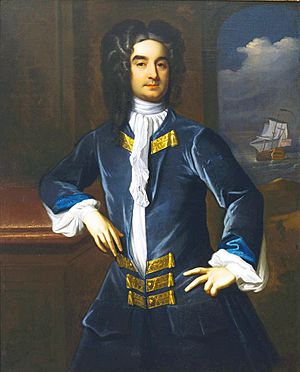
Spotswood also upset Virginia's rich families with another law. In December 1714, he passed the Indian Trade Act. This law gave a single company, the Virginia Indian Company, control over all trade with Indians south of the James River. Spotswood believed this would stop illegal trade and Indian unrest. However, William Byrd II, a powerful leader who traded a lot with the Cherokee, was very unhappy. He went to England to try and turn people against Spotswood.
The disagreements between Spotswood and the House of Burgesses grew worse in 1715. They challenged his new laws. Many representatives who supported Spotswood's laws lost their seats in elections. Spotswood closed the assembly after five weeks of arguments. He called the House of Burgesses "a Set of Representatives, whom Heaven has not generally endowed with the Ordinary Qualifications requisite to Legislators." This made them even angrier. In 1716, anonymous letters were sent to London, accusing Spotswood of being greedy and a tyrant.
Exploring the Western Frontier
Despite the political fights, Spotswood focused on exploring beyond Virginia's western border. The French were trying to connect their colonies in Canada with forts along the Mississippi River. Spotswood feared they would cut off the British from the interior lands.
In 1714, he helped explore the York and Mattaponi Rivers. He also set up two new settlements beyond the Tidewater area.
- Fort Christanna: Built on the Meherrin River, this fort was the headquarters for the Virginia Indian Company. It also had a school to teach Indians Christian ways. Spotswood wanted to help Indians settle down and become part of the British way of life.
- Germanna: Located on the Rapidan River, this settlement was for German refugees from the Palatinate. They had found silver and iron deposits there. Nine German families worked in the iron furnaces.
In October 1714, news arrived that Queen Anne had died. Spotswood announced the new king, George I of Great Britain. He told the House of Burgesses that the borders were safer, the economy was improving, and defense costs were down thanks to the new settlements.
The Golden Horseshoe Expedition
In 1716, Spotswood learned that rangers had found a passage through the mountains. He offered to lead an expedition himself. The Governor's Council approved, seeing the chance for new trade and land.
Spotswood left Williamsburg on August 20, 1716. He met his team at Germanna. On August 29, sixty-three men set off for the mountains. The group included important settlers, servants, rangers, and Native American guides. They also had many horses and dogs.
They followed the Rapidan River, hunting and celebrating the new king. Some men got sick and had to stay behind. The rest continued, facing bears and rattlesnakes. On September 5, they reached the source of the Rapidan River in the Blue Ridge Mountains.
They crossed the mountains through a pass called Swift Run Gap. Spotswood named one peak "George" for the king, and his companions named another "Alexander" for him. They then became the first Westerners to see the Shenandoah Valley. They explored the valley and reached the Shenandoah River, which Spotswood renamed Euphrates. They fired guns to honor the king and buried a bottle with a paper claiming the land for Britain.
On September 7, they started back to Germanna and were in Williamsburg ten days later. That winter, Spotswood gave each member of the expedition a small gold horseshoe. It had a Latin phrase engraved: Sic juvat transcendere montes ("This is the way to cross the mountains").
This trip became known as the "Knights of the Golden Horseshoe Expedition." It was a very exciting event in Virginia's history. It inspired many future explorers. The expedition also led to poems and novels, like William Alexander Caruthers' The Knights of the Golden Horse-Shoe.
Challenges from London and Virginia
The success of the expedition was liked in London. But soon, Spotswood faced new problems. In 1717, London merchants complained to the Board of Trade. They said Spotswood's laws hurt trade. They claimed that bad quality tobacco was still being sold, and the Virginia Indian Company's monopoly hurt their business.
The King then canceled the Tobacco Inspection Act and the Indian Trade Act. Spotswood had to remove them. William Byrd, who was in England, wrote that he helped get these laws canceled and weaken the governor's power.
The House of Burgesses also refused to fund Fort Christanna, so it had to be closed. Spotswood worried this would make the border unsafe. He still believed in the ideas behind the Indian Trade Act. Years later, the Tobacco Inspection Act was successfully brought back.
The House of Burgesses often opposed Spotswood. They didn't like his efforts to control the colony. Powerful men like Reverend James Blair, president of William and Mary's College, also worked against him. Blair had helped remove past governors. The main conflict was over who had the right to appoint judges. Spotswood believed the governor should, while the council members thought they should.
Despite these challenges, many ordinary Virginians, especially small landowners, supported Spotswood. He also still had the King's support in London.
Fighting Pirates and Indians
In 1717, Spotswood wrote that only pirates and aggressive Indians were causing problems. Some Seneca groups from New York were raiding Virginia's border.
In March 1717, Catawba tribe chiefs came to Fort Christanna to discuss a trade treaty. Spotswood joined them. One night, some enemy Indians attacked the fort, killing and kidnapping some Catawba. The Catawba thought the British had betrayed them. Spotswood quickly sent men to rescue the kidnapped, promised protection, and showed his friendship. The Catawba agreed to trade at the fort and send their children to study there. The border seemed to improve.
The biggest threat was pirates. The most famous was Edward Teach, known as Blackbeard. He had recently returned to piracy. When Blackbeard attacked ships near Charleston Harbor in May 1718, Carolina asked Virginia for help. Spotswood decided to act, even though it was outside his official power.
He arrested William Howard, a former pirate, who he suspected was still in touch with Blackbeard. From Howard, Spotswood learned Blackbeard was hiding at Ocracoke Inlet in North Carolina. Spotswood was determined to capture Blackbeard, dead or alive. He sent two warships under Lieutenant Robert Maynard. On November 22, 1718, Maynard found Blackbeard's ship. Blackbeard was killed in a short, bloody fight. Maynard returned with fifteen prisoners, who were later executed.
Political Truce and New Lands
Spotswood faced criticism for his actions against the pirates. Some members of the House of Burgesses said he acted illegally. They argued he should have consulted the governor of North Carolina. Spotswood likely knew the North Carolina governor was involved with pirates and purposely didn't ask for his help.
His relationship with the Governor's Council also got worse. In 1719, a dispute arose over who should appoint church leaders. James Blair and his group wanted parish assemblies to appoint clergy. Spotswood wanted the governor to have this power. Both sides asked the Bishop of London for help. The situation remained unresolved, which was a win for Blair.
Spotswood tried to change the council's members. In 1718, he asked London to remove Blair and Byrd. London only removed Byrd, who was quickly reinstated.
In 1720, things changed. Spotswood decided to make peace with the council members. William Byrd, now back in Virginia, became a key contact. They agreed to work together. On April 29, 1720, the governor and council officially declared they would work in harmony.
In this calmer period, Spotswood received large land grants near Germanna, about 86,000 acres. He began building his private home there. This land became the center of Spotsylvania County, named in his honor in 1720. The Governor's Palace and the Bruton Parish Church in Williamsburg, which Spotswood helped design, were also finished. The Governor's Palace was criticized for its cost but praised for its beautiful design.
This truce was short-lived. In 1721, Byrd and Blair went to England to continue their efforts against Spotswood.
Final Years as Governor
Spotswood believed Britain needed to expand further northwest, towards the Great Lakes. He wanted to gain an advantage over the French. He even had a map of the western Mississippi River System and planned an expedition to Lake Erie. He also wanted to conquer Spanish Florida to stop the French fleet from entering the Gulf of Mexico. These secret missions never happened.
During his last two years as governor, Spotswood focused on Native American relations. While piracy was declining, problems with hostile Indian tribes were growing. In 1720, tribes from Maryland attacked plantations in Virginia. Spotswood worked with the governor of Maryland to arrange a meeting with the Iroquois Confederation tribes.
The meeting took place in Williamsburg in October 1721. An agreement was reached: the Potomac River became the border between Virginia Indians and the Iroquois. No Indian could cross it without British permission.
Encouraged by this, Spotswood organized a larger meeting with Iroquois leaders. In June 1722, he sailed from Virginia with delegates from the council and House of Burgesses. They brought many gifts for the Iroquois. From New York, he traveled to Albany with other governors.
The British delegation arrived in Albany on August 20. It was the most important British meeting with Native Americans in the colonies. Leaders from almost all Iroquois nations attended. The conference began on August 29. Spotswood spoke first, hoping for continued cooperation. He gave pearl necklaces to the chiefs as a sign of goodwill. He asked them to confirm their promise to respect the Blue Ridge Mountains and Potomac River as borders. After ten days, the agreement was made.
On September 12, the conference ended. Spotswood gave the Iroquois chiefs a small gold horseshoe pin, like the ones he gave his expedition companions. He said they could use it as a pass to visit Williamsburg. He also gave them fabrics and tools. Then he left by ship.
End of His Governorship
When Spotswood returned to Williamsburg, he learned that the King had decided to remove him as governor. On September 25, 1722, James Blair and the new governor, Hugh Drysdale, arrived on the same ship. Drysdale officially became governor on September 27.
Historians disagree on why Spotswood was removed. Some say it was his strong, sometimes bossy, personality. He was used to military obedience, which Virginia's powerful families didn't like. He often clashed with merchants, landowners, and even his own men. The main reasons might have been arguments over who appointed judges or church leaders. His policies often went against the interests of Virginia's wealthy class, especially James Blair and William Byrd, who had the power to get a governor removed.
People at the time had different opinions of Spotswood. James Blair and William Byrd wrote harsh criticisms. But others, like historian Robert Beverley Jr., praised him. Hugh Jones, a professor at William and Mary's College, wrote in 1724 that Virginia had become more civilized in Spotswood's twelve years than in the previous hundred.
Most modern historians have a positive view of Spotswood's time as governor. They see him as a brilliant and important leader during a time of growth. Historian John Fiske called him one of the best governors in British colonial America. He praised Spotswood for starting the Germanna ironworks and for the brave Golden Horseshoe Expedition.
Life After Governorship
Business and Family
After being governor, Spotswood moved to his large estate near Germanna, along the Rappahannock River. He focused on managing his land and his iron-making business. He exported iron to England and sold some locally. He first used the German refugees he brought to Germanna, then later used slaves from Africa. He also raised livestock and produced naval supplies like pitch and tar.
Spotswood had gained a lot of land during his time as governor. Some people accused him of taking too much land. In 1724, he went to England to settle his taxes and confirm his land ownership. He stayed for five years.
At 48, Spotswood was still single. In London, he married Anne Butler Brayne, the daughter of a London gentleman. They had four children: two boys and two girls.
Return to America and Later Life
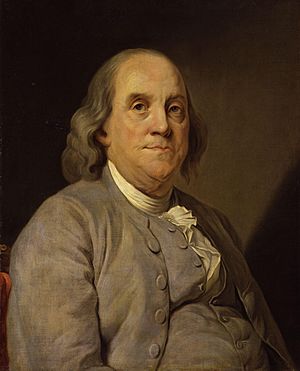
In February 1729, Spotswood returned to America with his wife and children. His ironworks had slowed down while he was away, but his estate was still doing well. His furnaces were the first stable iron production site in North America.
As a private citizen, Spotswood paid for a church in Germanna. He also built another large private home along the Rappahannock River, which was finished in 1732. This house was even bigger than the Governor's Palace! He made peace with William Byrd, who later described Spotswood's new home as an "enchanted castle."
Spotswood also bought another property near Yorktown called Temple Farm. Years later, this house, known as Moore House, was where General Charles Cornwallis signed the final British surrender during the American Revolution in 1781.
In his last years, Spotswood stayed out of politics. In 1730, he accepted a less public role: Postmaster General for the thirteen colonies and the West Indies. At that time, the postal system was small. In 1732, Spotswood expanded it to Williamsburg, where mail started arriving weekly. He also became friends with the young publisher Benjamin Franklin, appointing him postmaster for Philadelphia in 1737.
Final Chapter: War and Death
The War of Jenkins' Ear
In October 1739, Britain declared war on Spain. This conflict was called the War of Jenkins' Ear. It was named after an English captain whose ear was cut off by the Spanish. Spotswood, still interested in military matters, offered to raise a regiment of volunteers for service in South America.
His offer was accepted. He was promoted to major general and put in charge of American troops. He was to lead a military expedition against the Spanish fort of Cartagena de Indias in present-day Colombia.
His Last Days
In May 1740, Spotswood traveled to Annapolis, Maryland. He was there to meet with local governors and wait for his troops. But he became ill and died quickly on June 7, 1740, at age sixty-four.
The expedition to Cartagena was delayed for a year. When the British finally attacked, they were defeated. Spotswood was likely buried in Annapolis, but some believe his body was brought back to his Temple Farm property near Yorktown. His memory, especially his time as governor, lived on in Williamsburg for a long time.
See Also
- List of colonial governors of Virginia
- Knights of the Golden Horseshoe Expedition
- Germanna
- Blackbeard
- Benjamin Franklin


